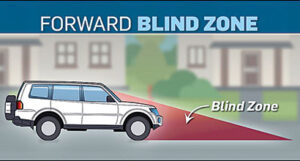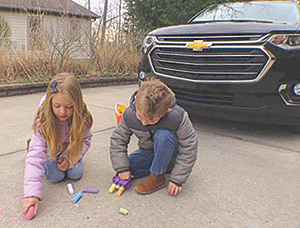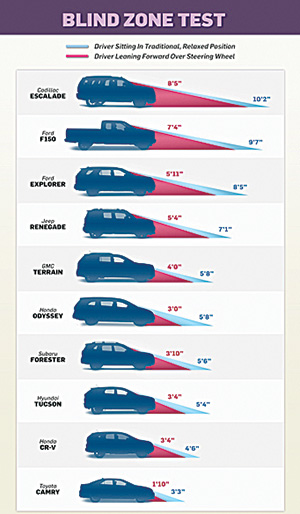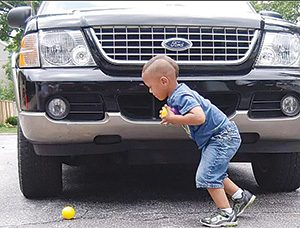 By KEVIN WEAKS
By KEVIN WEAKS

A recent report on NBC’s Nightly News told this heartbreaking story:
The day after Christmas 2016, Jenesee Beaudoin was moving her SUV in her parents’ San Antonio driveway, preparing to pack up her children’s presents, when she felt something under her wheels.
“It felt like I went off a curb,” she said. As she opened the car door to see what happened, her son began screaming his younger sister’s name from the doorway. “I ran to the back of my car and there she was in between my back tires.”
Beaudoin had left Briley, 2, in a living room full of adults. But once in the driver’s seat, she had no way to see that her daughter had wandered outside after her — right into the SUV’s front blind zone as she started the engine.
Briley died hours later at a hospital.
“I had a backup camera, but I wasn’t going backwards,” Beaudoin said. “It took seconds. It’s literally seconds and someone’s life is changed forever.”

Briley was one of an estimated 64 children who died that year after being hit by a forward-moving vehicle off of public roads, according to an NBC News analysis of federal crash data. More than twice as many children have died from such crashes when vehicles were moving forward rather than backward in recent years. An estimated 744 children were killed that way from 2016 to 2020, mostly in driveways and parking lots. In the majority of deaths, the child was hit by an SUV or a pickup truck.
SENATOR CALLS FOR INVESTIGATION
Every year, many kids get hit and die when their parents can’t see them in their front blind zones. A senator wants to pass a law requiring safety features to prevent these accidents.
U.S. Sen.Richard Blumenthal (D-Conn.) has expressed concern over vehicle blind spots after an NBC affiliate in Washington, D.C. aired a segment demonstrating how the blind spots on certain large SUV and truck models can put pedestrians at risk, particularly small children.
 Blumenthal was among the viewers who saw the segment and is now calling on the National Highway Traffic Safety Administration to investigate the matter more closely.
Blumenthal was among the viewers who saw the segment and is now calling on the National Highway Traffic Safety Administration to investigate the matter more closely.
“I’m extremely troubled that large blind zones in front of SUVs are reportedly causing senseless deaths of children,” Blumenthal said in a letter that was sent to NHTSA Administrator Steven Cliff. “In such instances, called frontovers,” tragedy strikes because a child in front of the car is not visible above the car’s hood and no warning occurs.”
BACKUP CAMERAS STANDARD, BUT NOT FRONTAL
Blumenthal suggested that NHTSA make mandatory a front-facing camera or sensors. They are currently optional on all but the most expensive vehicles.
Many modern-day large SUV and truck models carry a frontal blind zone of up to 16 feet, making it difficult to see children or smaller pedestrians standing in front of the vehicle. Congress ordered NHTSA to implement standard backup cameras in new production vehicles in 2007, which finally came into effect in 2014, but a similar rule does not apply to the front end of vehicles. Such a requirement could mandate large vehicles to include front-facing cameras or sensors to warn drivers of objects obstructing the vehicle’s path.
“It’s hard to understand why we’ve known this is a problem for so long, and we’ve had this solution sitting on a shelf that’s not being used everywhere in every car,” said Amber Rollins, director of Kids and Car Safety, an advocacy group that has been pushing for rear and front blind zone protections for decades. “There’s a solution out there, and yet families continue to bury their children.”
VEHICLES ARE GETTING BIGGER
Americans are buying bigger vehicles than they used to. Every category of midsize or larger SUVs and pickup trucks saw more than 20 percent growth in market share from 2012 to 2021, according to an NBC News analysis of Edmunds data. The most purchased new vehicle in the country for more than a decade has been the Ford F-150.
“Over time, people prefer trucks and SUVs over cars,” said Brian Moody, executive editor at Kelley Blue Book. “They’re increasingly family vehicles,” he said, “often with larger capacities and more comfort features than the sedans and vans families primarily drove.”
“Front blind zone technology is increasingly important because of those trends,” said Jennifer Stockburger, director of operations for the Consumer Reports Auto Test Center. “As cars have gotten bigger, visibility has gone down,” she said.
Pickup trucks in particular, have become larger. Last year, Consumer Reports found that the height of a pickup truck front hood — the top of a front blind zone — grew by an average of more than 11 percent and that truck weight went up 24 percent from 2000 to 2018.
“They’re heavy, and they keep getting taller and heavier,” Stockburger said. “A tall, square hood is particularly difficult to see around, regardless of the driver’s height. That’s a big safety concern,” she said. “The biggest vehicles, or vehicles with the most difficulty in terms of visibility, should be prioritized to get these cameras first.”
That’s already begun, according to automakers. “Safety is a top priority of the auto industry,” the Alliance for Automotive Innovation, an industry trade group, said. “Vehicles continue to get even more safe as automakers across the board test, develop and integrate new safety technologies that can help save lives and prevent injuries.”
While some vehicles do come standard now with front cameras, or with front sensors that can detect obstacles and may prevent accidents, they are often expensive or luxury vehicles.
INVISIBLE CHILDREN
NBC News examined that front visibility with a group of elementary school children, ages 6 to 10, and several adults of different heights in the driver’s seat of four tall, square-hooded vehicles: Ford F-150 and Toyota Tundra pickup trucks and Cadillac Escalade and Jeep Wagoneer SUVs.
With the kids seated in a line stretching forward from the vehicle’s front bumper, it took nine to 11 of them before a 5’ 2” driver could see a child’s head. Other demonstrations found similar results.
“If I was sitting comfortably the way I would sit in a car, I couldn’t see anything,” said Frida Berrigan, whose 6- and 10-year-old children were part of the demonstration group. “I thought, well, three kids, maybe three kids we wouldn’t be able to see. But to have a line of 10-12 kids and have them all be invisible was terrifying.”
Blumenthal, who is 5 feet-10, could not see any of the 12 children from the driver’s seat of the Escalade with its power, including its front camera, turned off.
“It’s potentially a parent’s worst nightmare,” he said.
(Contact Kevin Weaks at kweaks@labortribune.com.)
Tips to prevent ‘frontovers’ and ‘backovers’ to save lives
 It’s important to teach children not to play in, under or around vehicles. Make sure you know where all of your children are before you start to drive away, but with a full house – or a full neighborhood – you can never assume that everyone is out of harm’s way. In 70 percent of these accidents it is a parent or close relative behind the wheel.
It’s important to teach children not to play in, under or around vehicles. Make sure you know where all of your children are before you start to drive away, but with a full house – or a full neighborhood – you can never assume that everyone is out of harm’s way. In 70 percent of these accidents it is a parent or close relative behind the wheel.
To prevent accidents, experts recommend you always walk around your vehicle before moving it and teach your kids that drivers can’t always see them. Every driver should follow these simple steps before leaving a driveway or parking lot:
1. Walk around vehicle. Take 10 seconds to ensure the area is clear by walking all the around your vehicle before getting in the driver’s seat.
2. Listen and be aware. Once inside, roll down your windows and actively listen to what’s happening outside your vehicle.
3. Eliminate distractions. Put your phone in your purse or pocket before heading out. Turn down your radio and stop conversations as you prepare to leave your parking spot.

